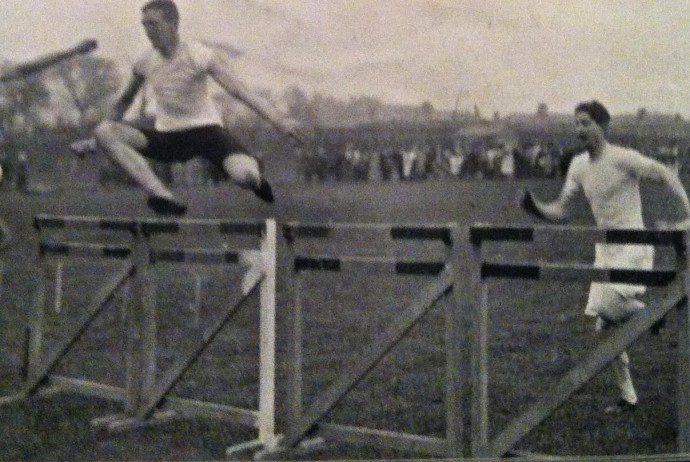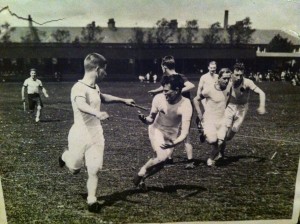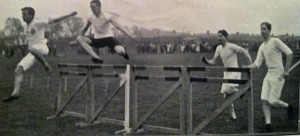It is well known that Clydesdale Harriers was the first open athletic club in Scotland and their first track race was held in 1885. They also had annual sports – mainly at Kinning Park and Ibrox but also at other football grounds such as the Meadowside (Partick Thistle), Celtic Park and even at Dunoon. But even were the club’s annual sports still extant, they would not be the oldest surviving sports meeting in the country. Prior to the Harriers, athletic sports were either carried on by the professionals or by the fee-paying schools such as Fettes and Loretto. The first of them all however was in Glasgow and organised by Glasgow Academy. We are grateful to Hugh Barrow for the information below and for all the pictures on the page. The Glasgow Academy Sports is maybe not a name that jumps out the athletics calendar at you, but it is an event that provides a timeline for the history of athletics in the west of Scotland and is probably the oldest surviving meeting in the west. The Academy is in Glasgow’s West End and was founded in 1845.
120 yards hurdles
It first saw light of day in May 1868 some fifteen years before the SAAA were formed in 1883 and has taken place every year since even throughout two World Wars. Originally organised as the Glasgow Academical Sports it was first held at the historic ground Burnbank which lay on the south side of Great Western Rd between present Park Rd and flyover on the M8 at St George’s Cross This ground was home at various times to Glasgow Accies Rugby Club, Rangers FC, various cricket clubs and saw the birth of the worlds oldest inter district rugby match when Glasgow first met Edinburgh in 1872 in the Inter City.
It can also lay claim to be the ground that gave William Smith the impetus to found the Boys Brigade as he drilled there with the 1st Lanarkshire Volunteer Rifles. He founded the Brigade just across the Great Western Rd in 1883. The Boys Brigade is an inter-denominational organisation which combined drill, fun activities and Christian values. It quickly spread throughout the United Kingdom and now has over half a million boys in 60 countries. The middle picture above show the BB drilling at Burnbank. But back to the sports.
Initially the Sports’ programme included a wide range of events for pupils and former pupils and also in clouded “strangers” races which in effect were open events that helped to encourage athletics in the area. It was common practice at the time for rugby and football clubs to host athletics meetings and this is reflected in the founder clubs of the SAAA. Over time the event moved to Kelvinside in the 1870s and then on to Old Anniesland in 1883 finally making its current venue New Anniesland in 1903. At the end of the Victorian era the sports had become a major social gathering with the Royal Scots Greys band stopping of to play en route to the Boer War
As part of the Sports they included a paper chase – also known as hares and hounds – where two runners (hares) set off carrying crescent shaped bags full of paper trimmings under their armpits and laid a trail, made up on the hoof, to be followed by the main pack (the hounds). The course finished at Burnbank and went as far as Balmore and Bardowie. Now largely built up, at that time it was clear country most of the way until they came back through Hillhead. The prime movers of this event were JW Arthur and Tom Chalmers who played rugby and cricket for Scotland almost made it for football as well! The actual route was as follows: meet at Bishopbriggs station – Cadder – Balmore – Glenorchard – Milngavie Road – Bardowie Loch – Allander Toll – Killermont – Canniesburn – Garscube – Great Western Road – Hyndland Road – Dowanhill – Hillhead – Burnbank.
Entry Ticket for the sports of 1879;
The event may not now have the status of yesteryear but it is not alone in this regard but it certainly has stood the test of time. There have been many top flight athletes taking part in the sports such as:
- Ginger MacLeod who won the SAAA 100 yards and became the first winner of the Scottish 220 yards championship in 1882 before going on to set a Scottish 120 yards record at the Ibrox Sports the same year.
- RS Stronach who became a Scotland rugby cap went on to win the British 120 yards hurdles in 1904, 1905 and 1906. His winning time in 1904 was identical to the winning time in the St Louis Olympics.
- John McIsaac who was a gold medallist in the European Championships 4 x 400m relay in 1958. He also broke Halswelle’s long standing record for 440 yards when he ran 48.0 seconds at Ibrox Sports.
- Hugh Barrow who was one of Scotland’s best ever milers
- Pat Maclagan who won the SAAA Marathon Championship in 1971.
- Alan Wilson who had a very good road running career.
- Alastair Douglas was a very good distance runner on all surfaces.



